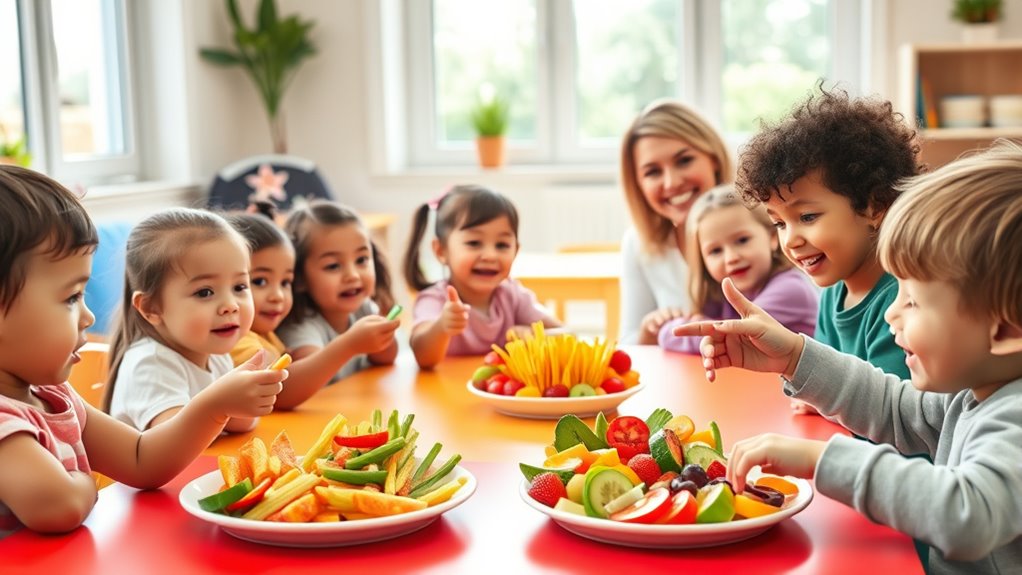To promote healthy eating habits in preschoolers, involve them in meal planning and preparation to boost their interest and confidence. Create a supportive environment by offering a variety of colorful, nutritious foods and encouraging sensory exploration with textures and smells. Make mealtime fun and pressure-free, reinforcing healthy choices as the default. By combining these strategies, you help establish lifelong habits. Keep exploring to discover more ways to foster your child’s healthy relationship with food.
Key Takeaways
- Involve preschoolers in meal planning and preparation to foster interest and confidence in healthy foods.
- Create a structured environment with colorful fruits, vegetables, and whole grains to encourage balanced eating.
- Use sensory food exploration to make mealtime engaging and reduce fussiness around new foods.
- Establish routine family meals that model healthy eating behaviors and reinforce nutritious choices.
- Ensure a positive, pressure-free atmosphere during eating to develop a lifelong healthy relationship with food.

Establishing healthy eating habits in preschoolers lays the foundation for lifelong well-being. As a caregiver or parent, your role in shaping their attitudes toward food is vital. One effective way to do this is through family meal planning, which allows you to create a structured environment where nutritious choices are easily accessible and consistently reinforced. When you plan meals together, your preschooler feels involved and valued, boosting their interest in trying new foods. Incorporate a variety of colorful fruits, vegetables, whole grains, and lean proteins into your weekly menu. By making healthy options the default, you help set a routine that promotes balanced eating habits over time. Additionally, family meal planning can serve as an opportunity to teach your child about portion sizes, food groups, and the importance of moderation, all in a relaxed setting. Engaging your preschooler in selecting and preparing meals can also foster a positive attitude toward food, encouraging lifelong healthy habits.
Sensory food exploration plays a pivotal role in helping preschoolers develop a positive relationship with food. Young children learn about their environment through their senses, so encouraging them to explore foods with their hands, noses, and taste buds can boost their willingness to try new things. You can introduce sensory activities, such as letting them feel the texture of different vegetables, smell herbs and spices, or observe the vibrant colors of various fruits. This hands-on approach makes mealtime fun and engaging, reducing food fussiness and picky eating. When you involve your preschooler in sensory food exploration, you’re not just teaching about nutrition but also fostering curiosity and confidence around food. It’s important to create a pressure-free environment where they feel free to investigate without fear of judgment. Over time, this exploration helps children accept a broader range of foods, which is essential for a well-rounded diet.
Frequently Asked Questions
How Can I Encourage Picky Eaters to Try New Foods?
To encourage picky eaters to try new foods, involve them in taste testing to make the experience fun and interactive. Offer small portions and let them explore different flavors without pressure. Use positive reinforcement like praise or rewards when they try something new, which builds confidence. Keep a cheerful attitude, and remember, patience is key—over time, they’ll become more open to trying a variety of healthy foods.
What Are Healthy Snack Options for Preschoolers?
You should offer nutritious snacks like sliced fruits, veggie sticks, or whole-grain crackers, ensuring they’re age-appropriate in portion size. Keep portions controlled to prevent overeating and make snacks appealing with colorful presentation. Incorporate a variety of foods to expose preschoolers to different tastes and textures. By providing balanced, portion-controlled options, you help foster healthy eating habits and make snack time both fun and nutritious.
How Does Mealtime Environment Influence Eating Habits?
You can positively influence eating habits by creating a calm mealtime ambiance, which helps preschoolers focus on their food and enjoy it. Seating arrangements matter too; providing consistent, comfortable spots encourages routine and reduces distractions. When you make mealtime pleasant and organized, children feel secure and are more likely to develop healthy eating habits, fostering better attitudes toward food and encouraging mindful eating in the long run.
When Should I Introduce New Foods to My Child?
Imagine your child’s curious eyes lighting up as they explore a colorful plate—this is when to introduce new foods. You should start at age-appropriate moments, around 12-18 months, when they’re ready for sensory exploration. Offer small portions, let them touch, smell, and taste, and keep introducing the same foods gently. This approach helps build positive eating habits and confidence in trying new flavors.
How Can I Make Healthy Eating Fun for Preschoolers?
You can make healthy eating fun for preschoolers by using colorful presentation to attract their attention and incorporating interactive activities. Serve vibrant fruits and veggies in creative shapes or fun containers, and involve them in preparing snacks. Encourage them to participate in activities like sorting or tasting new foods. These strategies turn eating into an engaging experience, helping kids develop positive habits while enjoying nutritious choices.
Conclusion
By guiding preschoolers toward healthy eating, you’re planting seeds like the wise gardener in the story of the Tortoise and the Hare—slow and steady wins the race. Your efforts help them build lifelong habits, shaping a future where nutrition and well-being flourish. Keep nurturing their curiosity and choices, knowing you’re crafting a foundation as enduring as the oak tree. With patience and love, you’re making a lasting impact—turning tiny steps into giant leaps for their health.








